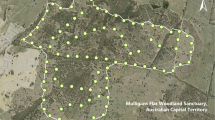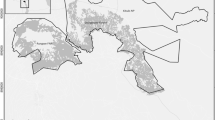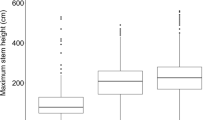Abstract
Although analyses of species spatial distributions and genetic variation, creation of Red Lists and reserve design studies predominate in the plant conservation biology literature, in any conservation project they should be only a second step succeeding population demographic assessments. Demographic studies and analysis of the species regeneration niche are vital because only such studies can identify the factors that determine the population fate, the stages of the life-cycle that are most important for the population viability, and the regeneration niche parameters. Using published demographic data, we modelled a situation when either seed production or survival of emerging seedlings occur intermittently. We found that when recruitment occurs intermittently, the population size frequency distribution deviates from inverse J-curve, but no gaps in size classes are observed unless seed germination and/or survival of emerging seedlings are extremely rare events. Then we use these results to interprete population demography of ten threatened tree species from Wuling Mountains, China, and come to a conclusion that their demographic structure can not be a result of natural processes. Taken together, our results show how important even a single population census can be if it includes counting seedlings and saplings, for determining population viability and appropriate population management. Two types of populations must be recognized as requiring different managements strategies: with regeneration naturally occurring (even if limited) and with no seedlings/saplings present. Populations from the first category can be subjected to such management actions as reinforcement using plant material of appropriate origin. Planting conspecifics can boost regeneration through increased seed production. However, reinforcement will make no sense in populations in which lack of regeneration is due to reasons other than seed limitation. In such populations long-term monitoring and study program must be established to understand the reasons for lack of regeneration.






Similar content being viewed by others
References
Aubréville A (1938) La forêt coloniale: Les forêts d’Afrique Occidentale Française. Annales de l’Academie des Sciences Coloniales 9:1–261
Bhuyan P, Khan ML, Tripathi RS (2003) Tree diversity and population structure in undisturbed and human-impacted stands of tropical wet evergreen forest in Arunachal Pradesh, Eastern Himalayas, India. Biodivers Conserv 12:1753–1773
Bin Y, Ye WH, Muller-Landau HC, Wu LF, Lian JY, Cao HL (2012) Unimodal tree size distributions possibly result from relatively strong conservatism in intermediate size classes. PLoS ONE 7:e52596
Bongers F, Popma J, Meave del Castillo J, Carabias J (1988) Structure and floristic composition of the lowland rain forest of Los Tuxtlas, Mexico. Veg Hist Archaeobot 74:55–88
Botzat A, Fischer L, Farwig N (2015) Regeneration potential in South African forest fragments: extinction debt paid off or hampered by contemporary matrix modification? Plant Ecol 216:535–551
Bunyavejchewin S, LaFrankie JV, Baker PJ, Kanzaki M, Ashton PS, Yamakura T (2003) Spatial distribution patterns of the dominant canopy dipterocarp species in a seasonal dry evergreen forest in Western Thailand. For Ecol Manag 175:87–101
Castro J, Gomez JM, Garcia D, Zamora R, Hodar JA (1999) Seed predation and dispersal in relict Scots pine forests in southern Spain. Plant Ecol 145:115–123
Caswell H (2001) Matrix population models: construction, analysis and interpretation. Sinauer Associates, Sunderland
Caughley G (1994) Directions in conservation biology. J Anim Ecol 63:215–244
Chen GX, Liao WB, Ao CQ, Liu WQ, Zhang HD (2002) Studies on character and feature of seed plants flora of Wulingshan region. Bull Bot Res 22:98–120 (in Chinese with English abstract)
Chen GX, Liao WB, Zhang HD (2001) Characteristics of spermatophyte flora of Mt.Wulingshan Region from central China and its phytogeographical significance. Acta Sci Nat Univ Sunyatseni 40:74–78 (in Chinese with English abstract)
Chen Y, Chen G, Yang J, Sun W (2016) Reproductive biology of Magnolia sinica (Magnoliaecea), a threatened species with extremely small populations in Yunnan, China. Plant Divers 38:253–258
Chien PD, Zuidema PA, Nghia NH (2008) Conservation prospects for threatened Vietnamese tree species: results from a demographic study. Popul Ecol 50:227–237
Condit R, Sukumar R, Hubbell SP, Foster RB (1998) Predicting population trends from size distributions: a direct test in a tropical tree community. Am Nat 152:495–509
de Souza IF, Souza AF, Pizo MA, Ganade G (2010) Using tree population size structures to assess the impacts of cattle grazing and eucalypts plantations in subtropical South America. Biodivers Conserv 19:1683–1698
Deb P, Sundriyal RC (2008) Tree regeneration and seedling survival patterns in old-growth lowland tropical rainforest in Namdapha National Park, north-east India. For Ecol Manag 255:3995–4006
Dennis B (2002) Allee effects in stochastic populations. Oikos 96:389–401
Ellstrand NC, Elam DR (1993) Population genetic consequences of small population size: implications for plant conservation. Annu Rev Ecol Evol Syst 24:217–242
Everard DA, Midgley JJ, Van Wyk GF (1995) Dynamics of some forests in Kwa Zulu-Natal, South Africa, based on ordinations and size-class distributions. S Afr J Bot 61:283–292
Fashing PJ, Forrestel A, Scully C, Cords M (2004) Long-term tree population dynamics and their implications for the conservation of the Kakamega Forest, Kenya. Biodivers Conserv 13:753–771
Franklin JF, Spies TA, Van Pelt R, Carey AB, Thornburgh DA, Berg DR, Lindenmayer DB, Harmon ME, Keeton WS, Shaw DC, Bible K, Chen JQ (2002) Disturbances and structural development of natural forest ecosystems with silvicultural implications, using Douglas-fir forests as an example. For Ecol Manag 155:399–423
Gabriel W, Burger R (1992) Survival of small populations under demographic stochasticity. Theor Popul Biol 41:44–71
Garcia D, Zamora R, Hodar JA, Gomez JM, Castro J (2000) Yew (Taxus baccata L.) regeneration is facilitated by fleshy-fruited shrubs in Mediterranean environments. Biol Conserv 95:31–38
Giroldo AB, Scariot A (2015) Land use and management affects the demography and conservation of an intensively harvested Cerrado fruit tree species. Biol Conserv 191:150–158
Goff FG, West D (1975) Canopy-understorey interaction effects on forest population structure. For Sci 21:98–108
Groom MJ (1998) Allee effects limit population viability of an annual plant. Am Nat 151:487–496
Hampe A, Arroyo J (2002) Recruitment and regeneration in populations of an endangered South Iberian Tertiary relict tree. Biol Conserv 107:263–271
Hobbs RJ, Yates CJ (2003) Impacts of ecosystem fragmentation on plant populations: generalising the idiosyncratic. Aust J Bot 51:471–488
Hubbell SP, Foster RB (1987) Large-scale spatial structure of a neotropical forest. Revista De Biologia Tropical 35:7–22
Isagi Y, Tateno R, Matsuki Y, Hirao A, Watanabe S, Shibata M (2007) Genetic and reproductive consequences of forest fragmentation for populations of Magnolia obovata. Ecol Res 22:382–389
Keim RF, Chambers JL, Hughes MS, Dimov LD, Conner WH, Shaffer GP, Gardiner ES, Day JW (2006) Long-term success of stump sprouts in high-graded baldcypress-water tupelo swamps in the Mississippi delta. For Ecol Manag 234:24–33
Keller LF, Waller DM (2002) Inbreeding effects in wild populations. Trends Ecol Evol 17:230–241
Klimas CA, Kainer KA, Wadt LHO (2007) Population structure of Carapa guianensis in two forest types in the southwestern Brazilian Amazon. For Ecol Manag 250:256–265
Knight DH (1975) A phytosociological analysis of species-rich tropical forest on Barro Colorado island, Panama. Ecol Monogr 45:259–284
Lázaro A, Traveset A, Méndez M (2006) Masting in Buxus balearica: assessing fruiting patterns and processes at a large spatial scale. Oikos 115:229–240
Loehle C, Li BL (1996) Habitat destruction and the extinction debt revisited. Ecol Appl 6:784–789
Lopez-A DM, Bock BC, Bedoya G (2008) Genetic structure in remnant populations of an endangered Andean Magnolia. Biotropica 40:375–379
Lopez-Toledo L, Horn C, Endress BA (2011) Distribution and population patterns of the threatened palm Brahea aculeata in a tropical dry forest in Sonora, Mexico. For Ecol Manag 261:1901–1910
Lykke AM (1998) Assessment of species composition change in savanna vegetation by means of woody plants’ size class distributions and local information. Biodivers Conserv 7:1261–1275
Malik ZA, Bhatt AB (2016) Regeneration status of tree species and survival of their seedlings in Kedarnath Wildlife Sanctuary and its adjoining areas in Western Himalaya, India. Trop Ecol 57:677–690
McLaren KP, McDonald MA, Hall JB, Healey JR (2005) Predicting species response to disturbance from size class distributions of adults and saplings in a Jamaican tropical dry forest. Plant Ecol 181:69–84
Menges ES (2000) Population viability analyses in plants: challenges and opportunities. Trends Ecol Evol 15:51–56
Midgley J, Seydack A, Reynell D, McKelly D (1990) Fine-grain pattern in Southern Cape plateau forests. J Veg Sci 1:539–546
Mooney KA, Linhart YB, Snyder MA (2011) Masting in ponderosa pine: comparisons of pollen and seed over space and time. Oecologia 165:651–661
Muller-Landau HC, Condit RS, Harms KE, Marks CO, Thomas SC, Bunyavejchewin S, Chuyong G, Co L, Davies S, Foster R (2006) Comparing tropical forest tree size distributions with the predictions of metabolic ecology and equilibrium models. Ecol Lett 9:589–602
Mwavu EN, Witkowski ETF (2009) Population structure and regeneration of multiple-use tree species in a semi-deciduous African tropical rainforest: implications for primate conservation. For Ecol Manag 258:840–849
Niklas KJ, Midgley JJ, Rand RH (2003) Tree size frequency distributions, plant density, age and community disturbance. Ecol Lett 6:405–411
Peres CA, Baider C, Zuidema PA et al (2003) Demographic threats to the sustainability of Brazil nut exploitation. Science 302:2112–2114
Poorter L, Bongers F, van Rompaey R, de Klerk M (1996) Regeneration of canopy tree species at five sites in West African moist forest. For Ecol Manag 84:61–69
Qian S, Tang CQ, Yi S, Zhao L, Song K, Yang Y (2017) Conservation and development in conflict: regeneration of wild Davidia involucrata (Nyssaceae) communities weakened by bamboo management in south-central China. Oryx 52:442–451
Richards PW (1952) The tropical rain forest: an ecological study. Cambridge University Press, Cambridge
Rigg LS, Enright NJ, Jaffré T, Perry GLW (2010) Contrasting population dynamics of the endemic New Caledonian conifer Araucaria laubenfelsii in maquis and rain forest. Biotropica 42:479–487
Rollet B (1978) Description, functioning and evolution of tropical forest ecosystems. 5. Organization. Tropical forest ecosystems. UNESCO, Paris
Sá D, Scariot A, Ferreira JB (2018) Effects of ecological and anthropogenic factors on population demography of the harvested Butia capitata palm in the Brazilian Cerrado. Biodivers Conserv. https://doi.org/10.1007/s10531-018-1669-9
Sanguinetti J, Kitzberger T (2008) Patterns and mechanisms of masting in the large-seeded southern hemisphere conifer Araucaria araucana. Austral Ecol 33:78–87
Schauber EM, Kelly D, Turchin P, Simon C, Lee WG, Allen RB, Payton IJ, Wilson PR, Cowan PE, Brockie RE (2002) Masting by eighteen New Zealand plant species: the role of temperature as a synchronizing cue. Ecology 83:1214–1225
Setsuko S, Nagamitsu T, Tomaru N (2013) Pollen flow and effects of population structure on selfing rates and female and male reproductive success in fragmented Magnolia stellata populations. BMC Ecol 13:10
Shaffer M (1987) Minimum viable populations: coping with uncertainty. In: Soule ME (ed) Viable populations for conservation. Cambridge University Press, Cambridge, pp 69–86
Steward G, Beveridge A (2010) A review of New Zealand kauri (Agathis australis (D. Don) Lindl.): its ecology, history, growth and potential for management for timber. NZ J For Sci 40:33–59
Suzuki W, Osumi K, Masaki T (2005) Mast seeding and its spatial scale in Fagus crenata in northern Japan. For Ecol Manag 205:105–116
Swetnam TW (1993) Fire history and climate change in giant sequoia groves. Science 262:885–889
Tang CQ, Yang Y, Ohsawa M, Momohara A, Hara M, Cheng S, Fan S (2011) Population structure of relict Metasequoia glyptostroboides and its habitat fragmentation and degradation in south-central China. Biol Conserv 144:279–289
Tang CQ, Yang Y, Momohara A, Wang H-C, Luu HT, Li S, Song K, Qian S, LePage B, Tang CQ et al (2019) Forest characteristics and population structure of Glyptostrobus pensilis, a globally endangered relict species of southeastern China. Plant Divers 41:237–249
Tilman D, May RM, Lehman CL, Nowak MA (1994) Habitat destruction and the extinction debt. Nature 371:65–66
Varghese A, Ticktin T, Mandle L, Nath S (2015) Assessing the effects of multiple stressors on the recruitment of fruit harvested trees in a tropical dry forest, Western Ghats, India. PLoS ONE 10:e0119634
Volis S (2016) How to conserve threatened Chinese species with extremely small populations? Plant Divers 38:53–62
Volis S (2018) Securing a future for China’s plant biodiversity through an integrated conservation approach. Plant Divers 40:91–105
Volis S (2019) Conservation-oriented restoration—a two for one method to restore both threatened species and their habitats. Plant Divers 41:50–58
Wang B, Chen G, Li C, Sun W (2017) Floral characteristics and pollination ecology of Manglietia ventii (Magnoliaceae), a plant species with extremely small populations (PSESP) endemic to South Yunnan of China. Plant Divers 39:52–59
Whitrnore TC (1975) Tropical rain forests of the Far East. Clarendon Press, Oxford
Wiegand K, Ward D, Thulke H-H, Jeltsch F (2000) From snapshot information to long-term population dynamics of Acacias by a simulation model. Plant Ecol 150:97–114
Wright SJ, Muller-Landau HC, Condit R, Hubbell SP (2003) Gap-dependent recruitment, realized vital rates, and size distributions of tropical trees. Ecology 84:3174–3185
York RA, Fuchs D, Battles JJ, Stephens SL (2010) Radial growth responses to gap creation in large, old Sequoiadendron giganteum. Appl Veg Sci 13:498–509
Young A, Boyle T, Brown T (1996) The population genetic consequences of habitat fragmentation for plants. Trends Ecol Evol 11:413–418
Zedler PH, Goff FG (1973) Size-association analysis of forest successional trends in Wisconsin. Ecol Monogr 43:79–94
Acknowledgements
We thank Dai-Gui Zhang for invaluable logistical help with the field work and Vernon Heywood and two anonymous reviewers for very fruitful comments on an early version of the manuscript.
Author information
Authors and Affiliations
Corresponding authors
Additional information
Communicated by Daniel Sanchez Mata.
Publisher's Note
Springer Nature remains neutral with regard to jurisdictional claims in published maps and institutional affiliations.
Rights and permissions
About this article
Cite this article
Volis, S., Deng, T. Importance of a single population demographic census as a first step of threatened species conservation planning. Biodivers Conserv 29, 527–543 (2020). https://doi.org/10.1007/s10531-019-01897-3
Received:
Revised:
Accepted:
Published:
Issue Date:
DOI: https://doi.org/10.1007/s10531-019-01897-3




